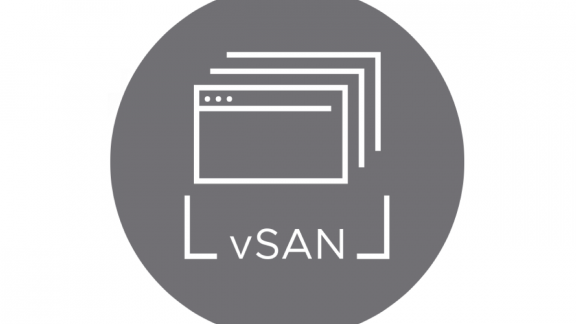Working remotely through the use of virtual desktops is more prevalent than ever before. As an example, I just saw my daughter writing SQL queries for a class she is taking online at Ohio University. She is logging on to a VMware Horizon virtual desktop from her MacBook Pro to securely access a Windows desktop where she writes and runs those SQL queries. It is great to see solutions such as Horizon and VMware Workspace ONE being used more and more. I know these have made my job easier.
HCI Makes a Great Foundation for Virtual Desktops
One of the keys to a good VDI user experience is the underlying compute and storage infrastructure. VMware vSphere as the hypervisor for a VDI environment provides an excellent compute foundation. vSphere has led the pack for many years in terms of consolidation ratios (number of VMs per physical host). This helps lower the cost per desktop by minimizing the number of hosts needed to run a given number of virtual desktops. Reliable network connections are required to ensure users can get connected and stay connected. Storage is a primary consideration that has a direct impact on TCO, user experience, and other advantages provided by VDI. Selecting the right storage for your virtual desktops provides multiple benefits such as high availability, a good user experience, and minimal cost.
These benefits can be achieved through the use of hyperconverged infrastructure (HCI) powered by VMware vSAN. vSAN enables multiple levels of resilience by mirroring and stripping data across drives and hosts to protect against various hardware failures. Redundancy and capacity consumption are easily and precisely controlled by the use of storage policy-based management with vSAN. Consistently high levels of uptime help ensure users can access a virtual desktop as needed without delay.
User experience is directly impacted by performance. A VDI environment is transient as multiple users log on, run applications, conduct virtual meetings, view training videos, send email, access databases, and so on throughout the workday, which is 24 hours in many places. Slow storage leads to slow apps, which affects productivity and makes users unhappy. vSAN delivers exceptional performance through a two-tier architecture using the latest flash technologies.
Minimize the Cost of VDI
Storage tends to be one of the more expensive components in any virtual desktop solution cost model. Minimizing storage expenditures reduces the cost-per-desktop. vSAN uses local x86 storage devices in each host to create a pool of high-performing, resilient storage that is shared across a vSphere cluster. There is no need for separate storage arrays, dedicated storage networking gear, and specialized cabling.
It is important to note that other HCI solutions typically require storage controller virtual machines, which lowers consolidation ratios. This is because virtual desktops are required to share resources with the controller virtual machines resulting in fewer virtual desktops per host. VDI is often a compute-bound workload. vSAN does not require CPU and memory reservations or controller virtual machines. vSphere has features such as best-of-breed memory management and vSphere Distributed Resource Scheduler (DRS) that lead to consolidation ratios better than competing hyperivsors. Virtual desktops running on vSphere and vSAN can fully utilize the all host resources to maximize user consolidation and lower per user costs.
Linked clone and instant clone technologies in Horizon go a long way in minimizing VDI storage consumption. Some HCI vendors claim deduplication, compression, and erasure coding provide significant storage savings for VDI. That is simply not the case unless you are provisioning a full virtual desktop clone for every user. Nearly all organizations with VMware Horizon use the linked clone and instant clone features to minimize storage capacity consumption. This is much more efficient than relying on storage services such as deduplication and compression to lower space usage.

Keep Things Secure
Security is another reason many organizations are using and expanding their VDI environment. The use of virtual desktops that reside in a controlled environment such as a data center or public cloud helps prevent important or sensitive data from being susceptible to loss or theft on devices such as laptops, home computers, tablets, and phones. vSAN features FIPS 140-2 validated data-at-rest encryption, which can be used to further secure data and comply with government and industry regulations. vSAN is also part of the vSphere Defense Information Systems Agency (DISA) Security Technical Implementation Guides (STIGs).
Beware of solutions that require users to have administrative access as this presents risk. Mature VDI solutions support two-factor authentication (2FA) and provide a good user experience without the challenges associated with giving everyone administrative or root privileges.
From Core HCI to the Software Defined Data Center
VMware Cloud Foundation takes the deployment and management of virtual desktops to the next level. Cloud Foundation automates the process of deploying, managing, and upgrading VDI workload domains. This includes the storage when using vSAN with Cloud Foundation. Automation eliminates manual processes, which are time-consuming and risky when mistakes are made. Cloud Foundation can orchestrate multiple workload domains. As an example, you might have production server workloads in one workload domain, a development environment in another workload domain, and virtual desktops in a third workload domain. This effectively provides the right levels of isolation across these environments while maintaining centralized management and monitoring. A full-stack, integrated solution also provides a consistent operational experience and it means you only have to call one support number if something does go wrong.
Conclusion
HCI powered by vSAN is the cornerstone of the modern data center. HCI is flexible and cost-effective making it suitable for a wide variety of server and virtual desktop use cases on-premises, at the edge, and in the cloud. Fast vSAN storage combined with Horizon cloning technologies and vSphere consolidation ratios provide an enterprise-class, cost-effective, secure platform for VDI.
Many VMware customers are already realizing the benefits of running virtual desktops on HCI. Here are just a few of these customers’ stories:
Here are a few more links to help you get started:



